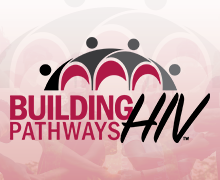About the Mobile Education Tool for Patients
Interventions and approaches to integrating HIV and mental health services: a systematic review.
Chuah FLH, Haldane VE, Cervero-Liceras F, et al. Health Policy Plan. 2017;32(suppl 4):iv27-iv47.
Strategies to improve access to and utilization of health care services and adherence to antiretroviral therapy among HIV-infected drug users.
Cunningham CO, Sohler NL, Cooperman NA, et al. Subst Use Misuse. 2011;46(2-3):218-232.
Integrating community health workers into HIV care teams: impact on HIV care outcomes.
Drainoni M-L, Baughman AL, Bachman SS, et al. J HIV/AIDS Soc Serv. 2020;19(3):204-219.
HIV treatment outcomes in POP-UP: drop-in HIV primary care model for people experiencing homelessness.
Hickey MD, Imbert E, Appa A, et al. J Infect Dis. 2022;226(Suppl 3):S353-s362.
A qualitative study of the barriers and enhancers to retention in care for pregnant and postpartum women living with HIV.
Humphrey J, Alera M, Kipchumba B, et al. PLoS Glob Public Health. 2021;1(10):e0000004.
Evaluation of the POP-UP programme: a multicomponent model of care for people living with HIV with homelessness or unstable housing.
Imbert E, Hickey MD, Clemenzi-Allen A, et al. AIDS. 2021;35(8):1241-1246.
One size does not fit all: preferences for HIV care delivery among out-of-care people living with HIV in the Southeastern United States.
Jones MD, Dyer K, Nedell ER, et al. PLoS One. 2023;18(1):e0276852.
Reporting on patients living with HIV “disengaging from care”. Who is actually “lost to follow-up”?
Krentz HB, McPhee P, Arbess G, et al. AIDS Care. 2021;33(1):114-120.
Designing an individually tailored multilevel intervention to increase engagement in HIV and substance use treatment among people who inject drugs with HIV: HPTN 074.
Lancaster KE, Miller WC, Kiriazova T, et al. AIDS Educ Prev. 2019;31(2):95-110.
Interventions to reengage people living with HIV who are lost to follow-up from HIV treatment programs: a systematic review and meta-analysis.
Mirzazadeh A, Eshun-Wilson I, Thompson RR, et al. PLoS Med. 2022;19(3):e1003940.
Strategies to reengage patients lost to follow up in HIV care in high income countries, a scoping review.
Palacio-Vieira J, Reyes-Urueña JM, Imaz A, et al. BMC Public Health. 2021;21(1):1596.
Outcomes from the adaptation of an evidence-based peer linkage & re-engagement intervention for women of color with HIV in three urban clinics.
Rajabiun S, Myers J, Goldberg J, et al. AIDS Behav. 2022;26(2):415-424.
“We need our own clinics”: adolescents’ living with HIV recommendations for a responsive health system.
Woollett N, Pahad S, Black V. PLoS One. 2021;16(7):e0253984.
PATIENT RESOURCES
 Mobile Education Tool for Patients
Mobile Education Tool for Patients
Click the link here to view the actual app where patients can get new information, tips, and tools to help make sure you’re getting the HIV care you need.
 PATIENT AWARENESS POSTER
PATIENT AWARENESS POSTER
Click here to download and print a poster that contains QR codes that link patients to motivational information and valuable community resources.
 COMMUNITY RESOURCE BUILDER
COMMUNITY RESOURCE BUILDER
Click here to utilize this easy online tool to build your own local community resource sheet that you can distribute to your patients.
CLINICAL PRACTICE GUIDELINES
Antiretroviral drugs for treatment and prevention of HIV infection in adults: 2022 recommendations of the International Antiviral Society–USA panel.
JAMA. 2023;329(1):63-84.
Guidelines for the use of antiretroviral agents in adults and adolescents living with HIV.
US Department of Health and Human Services.
CLINICIAN RESOURCES
Building HIV Pathways Video Modules
Review 6 short educational videos focusing on Adolescents, Women, Substance Use Disorder, Mental Health, Homelessness, and Trauma Informed Care.
Patient navigator program tools.
AIDS Education & Training Center Program.
Preferred terms for Select Population Groups & Communities.
Centers for Disease Control and Prevention.
Housing first in permanent supportive housing.
Department of Housing and Urban Development.
Harm Reduction International.
Trauma-informed approaches toolkit.
National Alliance of State and Territorial AIDS Directors.
National Harm Reduction Coalition.
National Health Care for the Homeless Council.
Lesson 8: Retention in HIV care.
National HIV Curriculum.
Words matter—terms to use and avoid when talking about addiction.
National Institute on Drug Abuse.
SAMHSA’s concept of trauma and guidance for a trauma-informed approach.
Substance Abuse and Mental Health Services Administration (SAMHSA). HHS Publication No. (SMA) 14-4884. Rockville, MD: Substance Abuse and Mental Health Services Administration, 2014.
Patient health questionnaire-2 (PHQ-2).
University of Washington.

Building HIV Pathways
Building Bridges to Reach People with HIV Toward the Goal of Re-engagement in Care
| Faculty: | Kellie Hawkins, MD; Stacey B. Trooskin, MD, PhD, MPH |
| Release: | 11/10/2023 |
| Expiration: | 11/10/2024 |






